PONTIAC GRAND PRIX 2006 Owners Manual
Manufacturer: PONTIAC, Model Year: 2006, Model line: GRAND PRIX, Model: PONTIAC GRAND PRIX 2006Pages: 472, PDF Size: 2.82 MB
Page 381 of 472
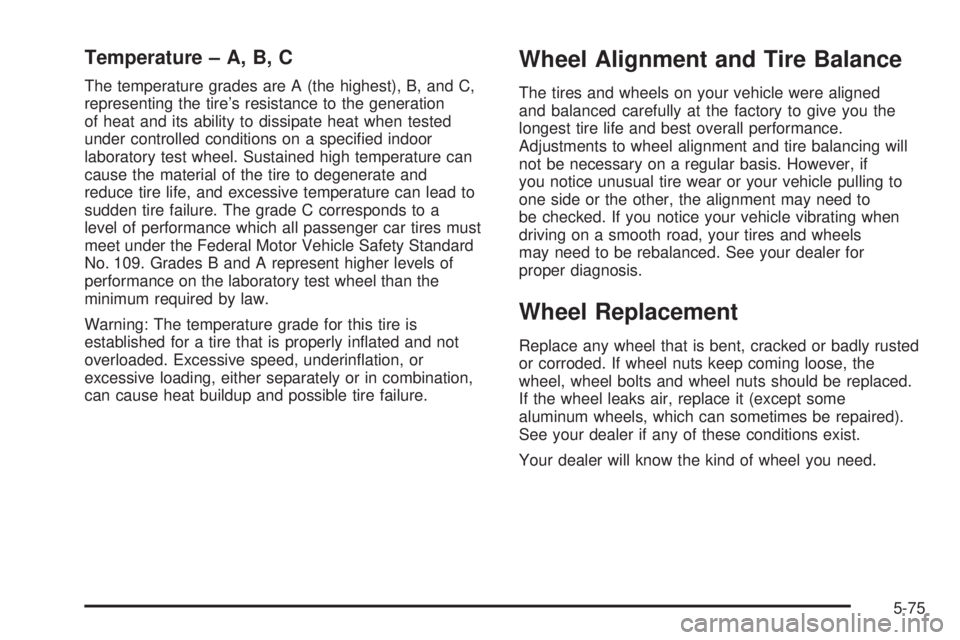
Temperature – A, B, C
The temperature grades are A (the highest), B, and C,
representing the tire’s resistance to the generation
of heat and its ability to dissipate heat when tested
under controlled conditions on a speci�ed indoor
laboratory test wheel. Sustained high temperature can
cause the material of the tire to degenerate and
reduce tire life, and excessive temperature can lead to
sudden tire failure. The grade C corresponds to a
level of performance which all passenger car tires must
meet under the Federal Motor Vehicle Safety Standard
No. 109. Grades B and A represent higher levels of
performance on the laboratory test wheel than the
minimum required by law.
Warning: The temperature grade for this tire is
established for a tire that is properly in�ated and not
overloaded. Excessive speed, underin�ation, or
excessive loading, either separately or in combination,
can cause heat buildup and possible tire failure.
Wheel Alignment and Tire Balance
The tires and wheels on your vehicle were aligned
and balanced carefully at the factory to give you the
longest tire life and best overall performance.
Adjustments to wheel alignment and tire balancing will
not be necessary on a regular basis. However, if
you notice unusual tire wear or your vehicle pulling to
one side or the other, the alignment may need to
be checked. If you notice your vehicle vibrating when
driving on a smooth road, your tires and wheels
may need to be rebalanced. See your dealer for
proper diagnosis.
Wheel Replacement
Replace any wheel that is bent, cracked or badly rusted
or corroded. If wheel nuts keep coming loose, the
wheel, wheel bolts and wheel nuts should be replaced.
If the wheel leaks air, replace it (except some
aluminum wheels, which can sometimes be repaired).
See your dealer if any of these conditions exist.
Your dealer will know the kind of wheel you need.
5-75
Page 382 of 472
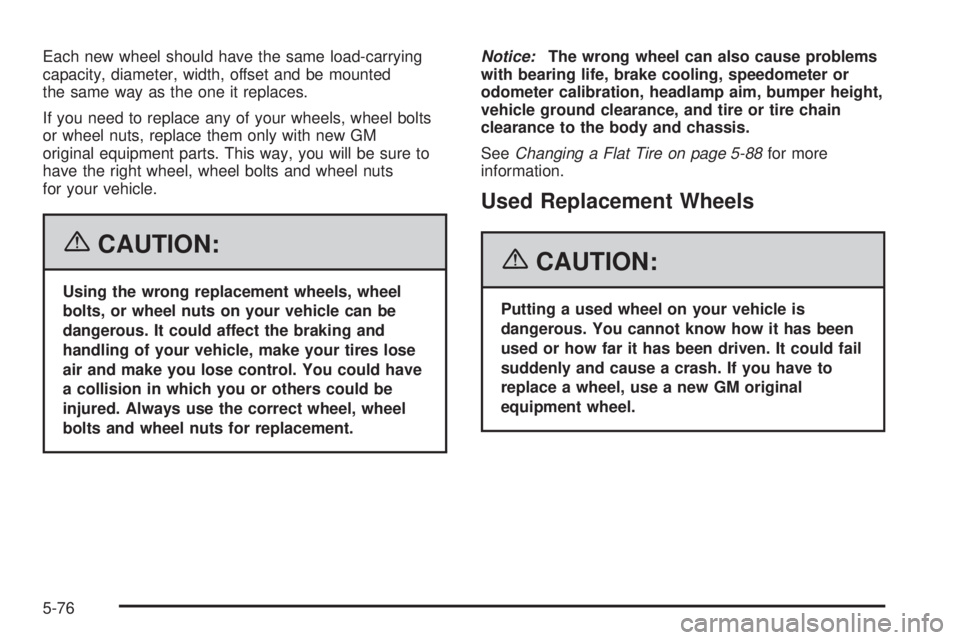
Each new wheel should have the same load-carrying
capacity, diameter, width, offset and be mounted
the same way as the one it replaces.
If you need to replace any of your wheels, wheel bolts
or wheel nuts, replace them only with new GM
original equipment parts. This way, you will be sure to
have the right wheel, wheel bolts and wheel nuts
for your vehicle.
{CAUTION:
Using the wrong replacement wheels, wheel
bolts, or wheel nuts on your vehicle can be
dangerous. It could affect the braking and
handling of your vehicle, make your tires lose
air and make you lose control. You could have
a collision in which you or others could be
injured. Always use the correct wheel, wheel
bolts and wheel nuts for replacement.Notice:The wrong wheel can also cause problems
with bearing life, brake cooling, speedometer or
odometer calibration, headlamp aim, bumper height,
vehicle ground clearance, and tire or tire chain
clearance to the body and chassis.
SeeChanging a Flat Tire on page 5-88for more
information.
Used Replacement Wheels
{CAUTION:
Putting a used wheel on your vehicle is
dangerous. You cannot know how it has been
used or how far it has been driven. It could fail
suddenly and cause a crash. If you have to
replace a wheel, use a new GM original
equipment wheel.
5-76
Page 383 of 472
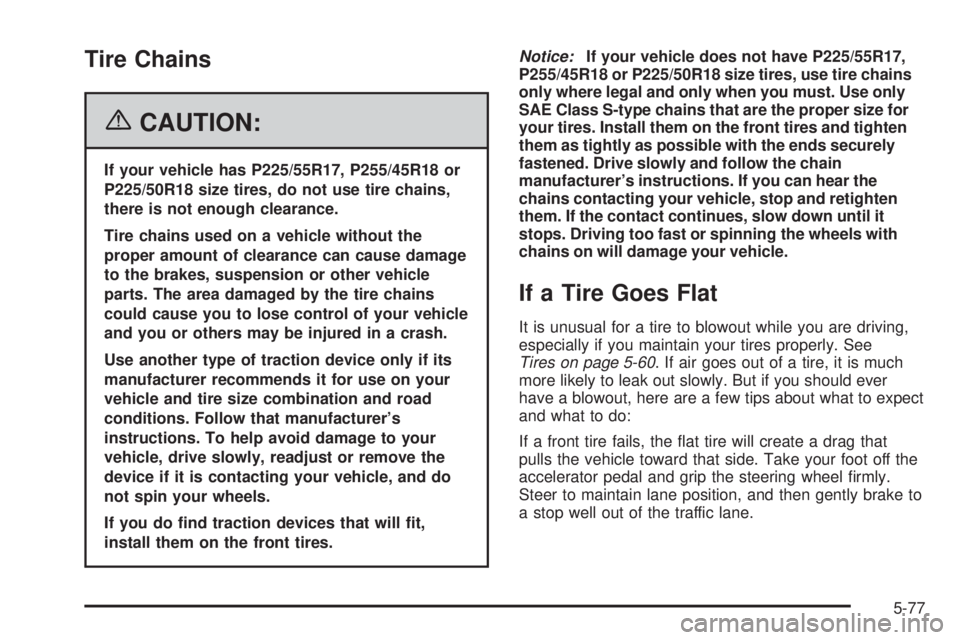
Tire Chains
{CAUTION:
If your vehicle has P225/55R17, P255/45R18 or
P225/50R18 size tires, do not use tire chains,
there is not enough clearance.
Tire chains used on a vehicle without the
proper amount of clearance can cause damage
to the brakes, suspension or other vehicle
parts. The area damaged by the tire chains
could cause you to lose control of your vehicle
and you or others may be injured in a crash.
Use another type of traction device only if its
manufacturer recommends it for use on your
vehicle and tire size combination and road
conditions. Follow that manufacturer’s
instructions. To help avoid damage to your
vehicle, drive slowly, readjust or remove the
device if it is contacting your vehicle, and do
not spin your wheels.
If you do �nd traction devices that will �t,
install them on the front tires.Notice:If your vehicle does not have P225/55R17,
P255/45R18 or P225/50R18 size tires, use tire chains
only where legal and only when you must. Use only
SAE Class S-type chains that are the proper size for
your tires. Install them on the front tires and tighten
them as tightly as possible with the ends securely
fastened. Drive slowly and follow the chain
manufacturer’s instructions. If you can hear the
chains contacting your vehicle, stop and retighten
them. If the contact continues, slow down until it
stops. Driving too fast or spinning the wheels with
chains on will damage your vehicle.
If a Tire Goes Flat
It is unusual for a tire to blowout while you are driving,
especially if you maintain your tires properly. See
Tires on page 5-60. If air goes out of a tire, it is much
more likely to leak out slowly. But if you should ever
have a blowout, here are a few tips about what to expect
and what to do:
If a front tire fails, the �at tire will create a drag that
pulls the vehicle toward that side. Take your foot off the
accelerator pedal and grip the steering wheel �rmly.
Steer to maintain lane position, and then gently brake to
a stop well out of the traffic lane.
5-77
Page 384 of 472
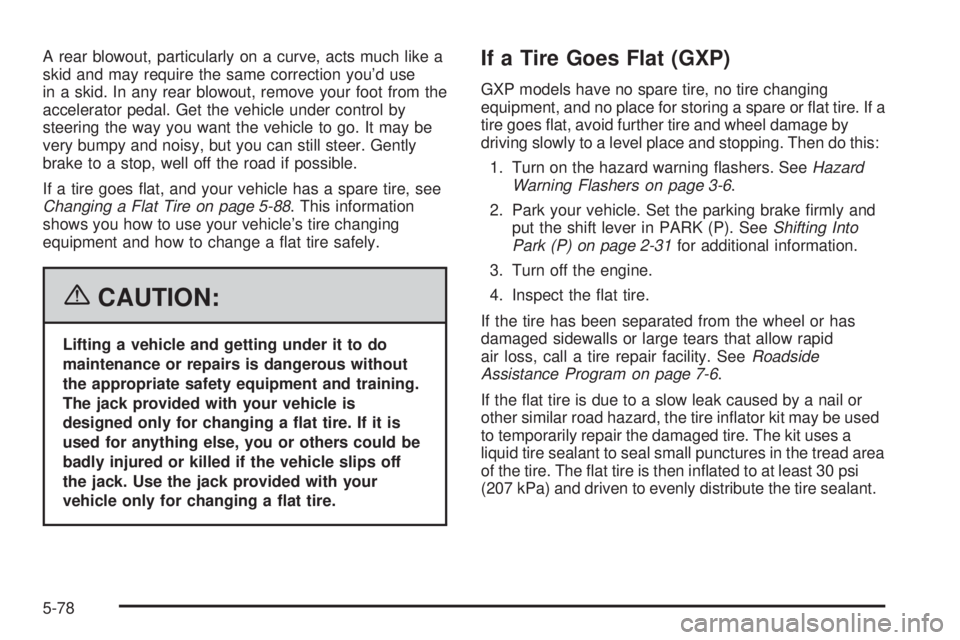
A rear blowout, particularly on a curve, acts much like a
skid and may require the same correction you’d use
in a skid. In any rear blowout, remove your foot from the
accelerator pedal. Get the vehicle under control by
steering the way you want the vehicle to go. It may be
very bumpy and noisy, but you can still steer. Gently
brake to a stop, well off the road if possible.
If a tire goes �at, and your vehicle has a spare tire, see
Changing a Flat Tire on page 5-88. This information
shows you how to use your vehicle’s tire changing
equipment and how to change a �at tire safely.
{CAUTION:
Lifting a vehicle and getting under it to do
maintenance or repairs is dangerous without
the appropriate safety equipment and training.
The jack provided with your vehicle is
designed only for changing a �at tire. If it is
used for anything else, you or others could be
badly injured or killed if the vehicle slips off
the jack. Use the jack provided with your
vehicle only for changing a �at tire.
If a Tire Goes Flat (GXP)
GXP models have no spare tire, no tire changing
equipment, and no place for storing a spare or �at tire. If a
tire goes �at, avoid further tire and wheel damage by
driving slowly to a level place and stopping. Then do this:
1. Turn on the hazard warning �ashers. SeeHazard
Warning Flashers on page 3-6.
2. Park your vehicle. Set the parking brake �rmly and
put the shift lever in PARK (P). SeeShifting Into
Park (P) on page 2-31for additional information.
3. Turn off the engine.
4. Inspect the �at tire.
If the tire has been separated from the wheel or has
damaged sidewalls or large tears that allow rapid
air loss, call a tire repair facility. SeeRoadside
Assistance Program on page 7-6.
If the �at tire is due to a slow leak caused by a nail or
other similar road hazard, the tire in�ator kit may be used
to temporarily repair the damaged tire. The kit uses a
liquid tire sealant to seal small punctures in the tread area
of the tire. The �at tire is then in�ated to at least 30 psi
(207 kPa) and driven to evenly distribute the tire sealant.
5-78
Page 385 of 472
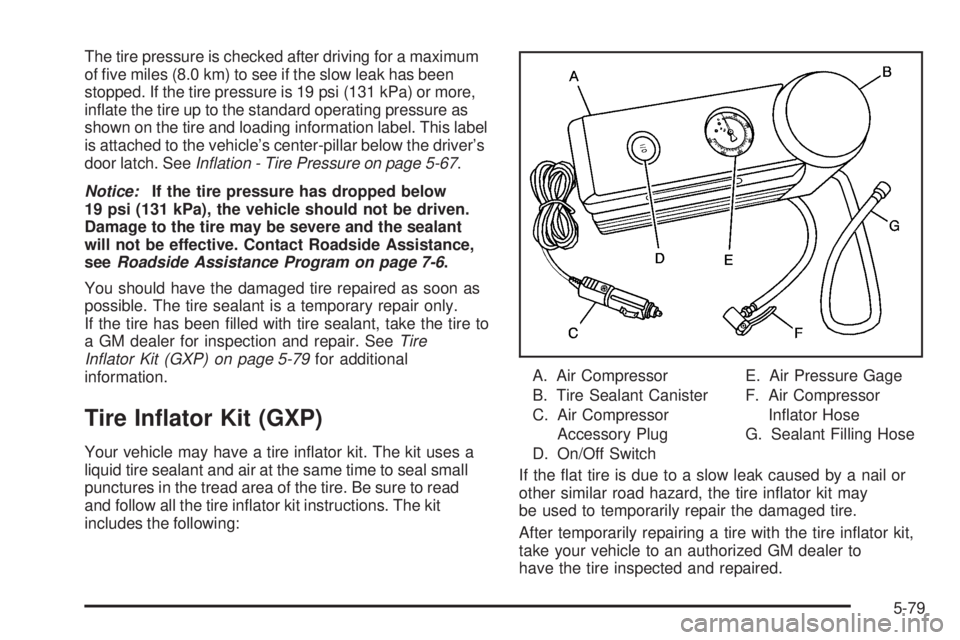
The tire pressure is checked after driving for a maximum
of �ve miles (8.0 km) to see if the slow leak has been
stopped. If the tire pressure is 19 psi (131 kPa) or more,
in�ate the tire up to the standard operating pressure as
shown on the tire and loading information label. This label
is attached to the vehicle’s center-pillar below the driver’s
door latch. SeeIn�ation - Tire Pressure on page 5-67.
Notice:If the tire pressure has dropped below
19 psi (131 kPa), the vehicle should not be driven.
Damage to the tire may be severe and the sealant
will not be effective. Contact Roadside Assistance,
seeRoadside Assistance Program on page 7-6.
You should have the damaged tire repaired as soon as
possible. The tire sealant is a temporary repair only.
If the tire has been �lled with tire sealant, take the tire to
a GM dealer for inspection and repair. SeeTire
In�ator Kit (GXP) on page 5-79for additional
information.
Tire In�ator Kit (GXP)
Your vehicle may have a tire in�ator kit. The kit uses a
liquid tire sealant and air at the same time to seal small
punctures in the tread area of the tire. Be sure to read
and follow all the tire in�ator kit instructions. The kit
includes the following:A. Air Compressor
B. Tire Sealant Canister
C. Air Compressor
Accessory Plug
D. On/Off SwitchE. Air Pressure Gage
F. Air Compressor
In�ator Hose
G. Sealant Filling Hose
If the �at tire is due to a slow leak caused by a nail or
other similar road hazard, the tire in�ator kit may
be used to temporarily repair the damaged tire.
After temporarily repairing a tire with the tire in�ator kit,
take your vehicle to an authorized GM dealer to
have the tire inspected and repaired.
5-79
Page 386 of 472
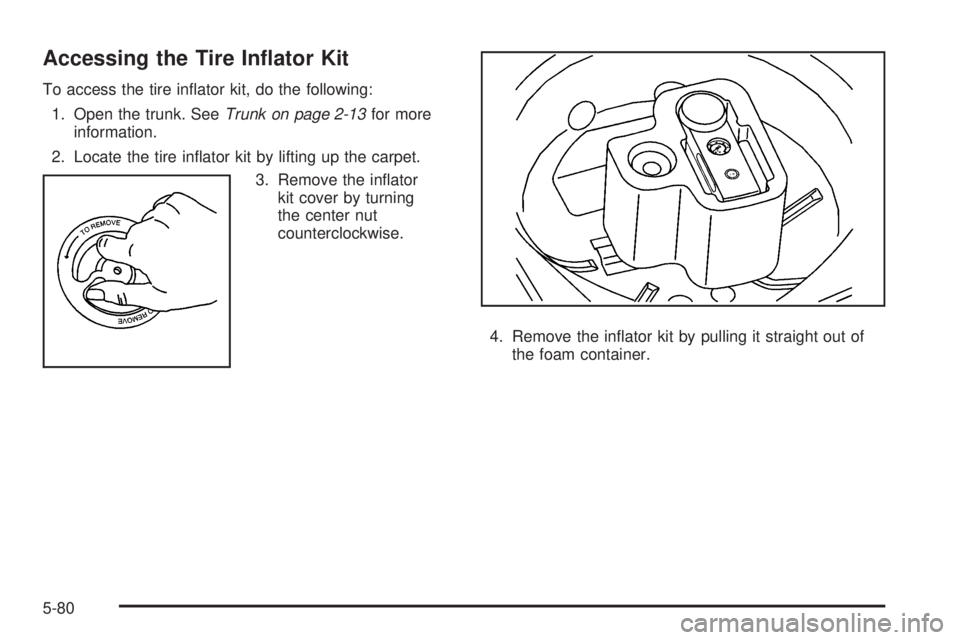
Accessing the Tire In�ator Kit
To access the tire in�ator kit, do the following:
1. Open the trunk. SeeTrunk on page 2-13for more
information.
2. Locate the tire in�ator kit by lifting up the carpet.
3. Remove the in�ator
kit cover by turning
the center nut
counterclockwise.
4. Remove the in�ator kit by pulling it straight out of
the foam container.
5-80
Page 387 of 472
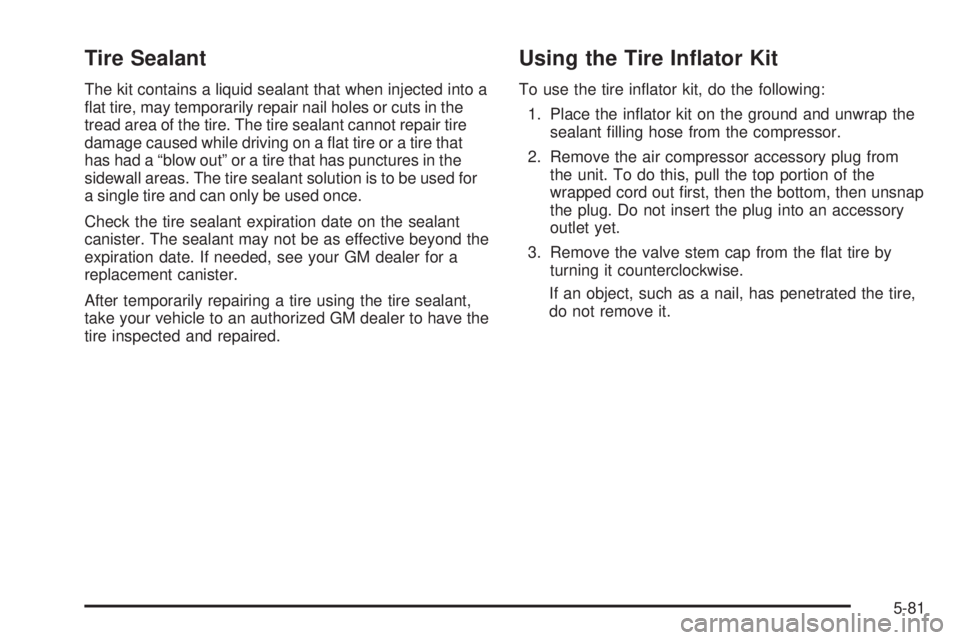
Tire Sealant
The kit contains a liquid sealant that when injected into a
�at tire, may temporarily repair nail holes or cuts in the
tread area of the tire. The tire sealant cannot repair tire
damage caused while driving on a �at tire or a tire that
has had a “blow out” or a tire that has punctures in the
sidewall areas. The tire sealant solution is to be used for
a single tire and can only be used once.
Check the tire sealant expiration date on the sealant
canister. The sealant may not be as effective beyond the
expiration date. If needed, see your GM dealer for a
replacement canister.
After temporarily repairing a tire using the tire sealant,
take your vehicle to an authorized GM dealer to have the
tire inspected and repaired.
Using the Tire In�ator Kit
To use the tire in�ator kit, do the following:
1. Place the in�ator kit on the ground and unwrap the
sealant �lling hose from the compressor.
2. Remove the air compressor accessory plug from
the unit. To do this, pull the top portion of the
wrapped cord out �rst, then the bottom, then unsnap
the plug. Do not insert the plug into an accessory
outlet yet.
3. Remove the valve stem cap from the �at tire by
turning it counterclockwise.
If an object, such as a nail, has penetrated the tire,
do not remove it.
5-81
Page 388 of 472

4. Attach the sealant �lling hose (A) onto the tire valve
stem. Turn it clockwise until it is tight.
Make sure the in�ator kit on/off switch (B) is in the
O (off) position.
5. Plug the air compressor accessory plug (C) into an
accessory power outlet in the vehicle. See
Accessory Power Outlet(s) on page 3-24for more
information.
{CAUTION:
Idling the engine in a closed-in place or with
the climate control system off can cause
deadly carbon monoxide (CO). SeeEngine
Exhaust on page 2-33.
6. Start the vehicle. SeeStarting the Engine on
page 2-23for more information. The vehicle must be
running while using the air compressor.
{CAUTION:
In�ating something too much can make it
explode, and you or others could be injured.
Be sure to read the in�ator instructions, and
in�ate the tire to its recommended pressure.
Do not exceed 36 psi (248 kPa).
7. Move the in�ator kit switch to the I (on) position.
The in�ator kit will force sealant and air into the
tire. Sealant may leak from the puncture hole until
the vehicle is driven and the hole has sealed.
5-82
Page 389 of 472
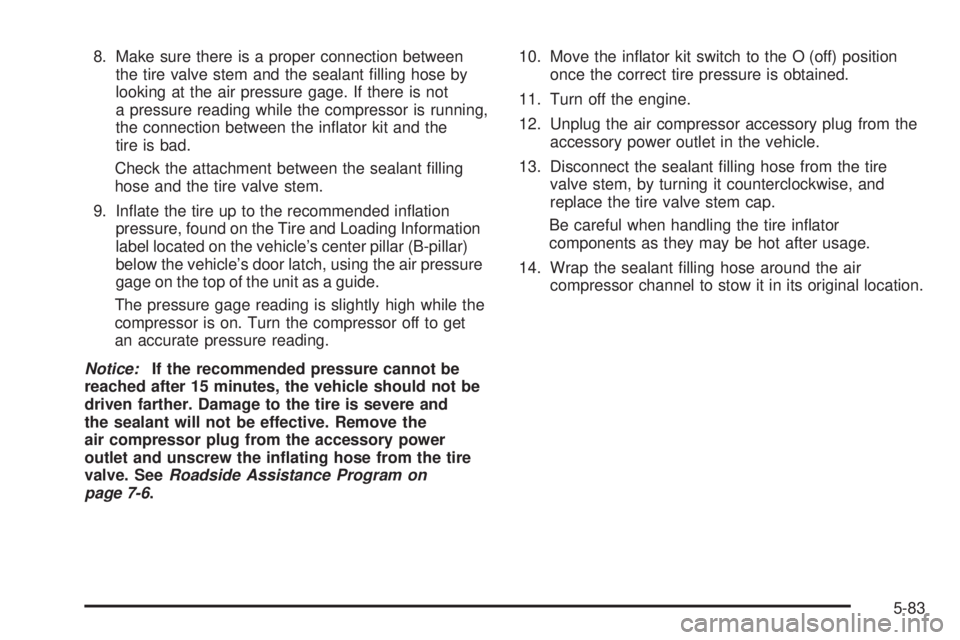
8. Make sure there is a proper connection between
the tire valve stem and the sealant �lling hose by
looking at the air pressure gage. If there is not
a pressure reading while the compressor is running,
the connection between the in�ator kit and the
tire is bad.
Check the attachment between the sealant �lling
hose and the tire valve stem.
9. In�ate the tire up to the recommended in�ation
pressure, found on the Tire and Loading Information
label located on the vehicle’s center pillar (B-pillar)
below the vehicle’s door latch, using the air pressure
gage on the top of the unit as a guide.
The pressure gage reading is slightly high while the
compressor is on. Turn the compressor off to get
an accurate pressure reading.
Notice:If the recommended pressure cannot be
reached after 15 minutes, the vehicle should not be
driven farther. Damage to the tire is severe and
the sealant will not be effective. Remove the
air compressor plug from the accessory power
outlet and unscrew the in�ating hose from the tire
valve. SeeRoadside Assistance Program on
page 7-6.10. Move the in�ator kit switch to the O (off) position
once the correct tire pressure is obtained.
11. Turn off the engine.
12. Unplug the air compressor accessory plug from the
accessory power outlet in the vehicle.
13. Disconnect the sealant �lling hose from the tire
valve stem, by turning it counterclockwise, and
replace the tire valve stem cap.
Be careful when handling the tire in�ator
components as they may be hot after usage.
14. Wrap the sealant �lling hose around the air
compressor channel to stow it in its original location.
5-83
Page 390 of 472
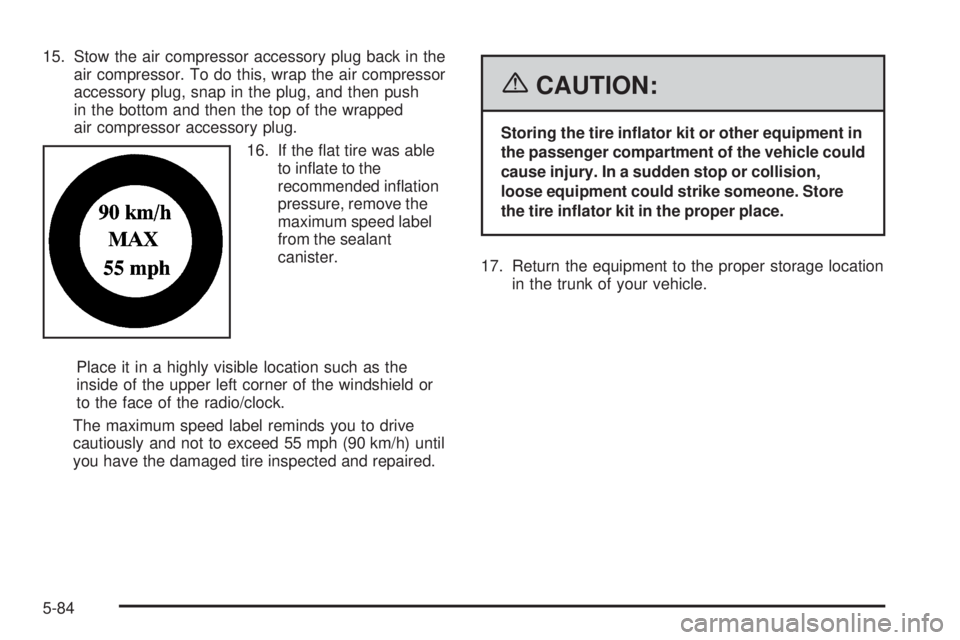
15. Stow the air compressor accessory plug back in the
air compressor. To do this, wrap the air compressor
accessory plug, snap in the plug, and then push
in the bottom and then the top of the wrapped
air compressor accessory plug.
16. If the �at tire was able
to in�ate to the
recommended in�ation
pressure, remove the
maximum speed label
from the sealant
canister.
Place it in a highly visible location such as the
inside of the upper left corner of the windshield or
to the face of the radio/clock.
The maximum speed label reminds you to drive
cautiously and not to exceed 55 mph (90 km/h) until
you have the damaged tire inspected and repaired.
{CAUTION:
Storing the tire in�ator kit or other equipment in
the passenger compartment of the vehicle could
cause injury. In a sudden stop or collision,
loose equipment could strike someone. Store
the tire in�ator kit in the proper place.
17. Return the equipment to the proper storage location
in the trunk of your vehicle.
5-84